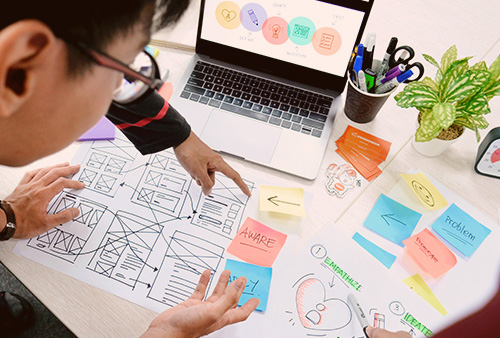
Jump To Section
- 1 What is a Product Life Cycle?
- 2 What is User Experience Design?
- 3 How the Best Design Performers Increase Revenues in the Product Life Cycle
- 4 Why is UI/UX Design Important in the Product Life Cycle?
- 5 What Does the User Experience Design Thinking Process Look Like?
- 6 How To Practice Good User Experience Design in the Product Life Cycle
- 7 Takeaway: Key Benefits of Integrating UX in Product Life Cycle
A big part of any organization’s growth now relies on providing a great user experience.
And hence, some of the biggest product development companies now focus a great deal on user experience design. In the product life cycle, UX design provides multiple benefits, making it easy to see why and how good user experience design should be an integral part of the process.
What is a Product Life Cycle?
The product life cycle refers to the set of strategies that are used at different stages during the product’s development for purposes of sales and marketing.
If we look at the product life cycle through an abstract lens, we find five distinct stages in the product life cycle:
- Conceptualization and Technology Development
- Product Development
- Market Introduction
- Market Acceptance Growth
- Normal Market Cycle
Apart from this, the product life cycle can also otherwise be defined as amount of time that a product spends from being introduced into the market until the time it is taken off the shelves.
The product life cycle assumes that most products have different life spans, and therefore, at each stage of the cycle, the business faces a different set of advantages and disadvantages.
This is why, when working on any product, it’s crucial to be a critical thinker to identify all edge cases that you could face during future processes of new product development.
There needs to be a lot of focus on the current and future consequences of the product, and to overcome such situations, businesses can adopt different processes and strategies to approach design, development, and marketing.
What is User Experience Design?
User experience design (or UX design) is simply the experience of your customers during their interaction with your product or service. How easily users can navigate through this experience and how simple (or complicated) it is for them to achieve what they want is all a part of user experience design.
The user experience can make or break your customer experience — and hence be a deciding factor when the question arises of whether your customer will want to stick with your product or move on to the next best option.
So, when it comes to achieving great user experience design, it’s important to make this consideration throughout the product life cycle to improve product growth and increase revenue streams.
How the Best Design Performers Increase Revenues in the Product Life Cycle
If we refer to extensive research from McKinsey on the subject, companies with top-quartile design scores outperformed the industry-benchmark growth by a ratio of as much as two to one.

You will be amazed after looking at the graph below about how shareholders got the revenue after implementing the design into their businesses.
Why is UI/UX Design Important in the Product Life Cycle?
The potential for design-driven growth is enormous in both product and service-based organizations.
Customers can feed opinions back to the companies in real-time, allowing the design to be measured by customers themselves — whether or not companies want to listen.

Although UX requires a lot of work and time, there are several techniques that play an important role in the product life cycle.

Without UX, most teams end up facing several issues and difficulties after the product is released. This is where UX comes in, helping with not only avoiding any issues but also ensuring you identify them during the product life cycle and not after release.
What Does the User Experience Design Thinking Process Look Like?
As UX affects every aspect of the product being built, the UX or Experience Designer is involved throughout the product life cycle.
Essentially, the UX designer designs the end-to-end experience of the product, which includes the complete design thinking process depending on the nature of the product.
The design thinking process always varies from product to product. Your process could change if you are working on an existing product and you want to add some new features.
The UX designer’s task is to be aware of all the problems and pain points with viable solutions, and convey those results to any and every element with which it is associated within the product life cycle.
Working as a UX designer is really important in the user experience lifecycle to understand why we need to define the problem, discover pain points, ask important questions like the whys and whats, and conduct user research before getting into the design phase.
Sometimes, there might also be the need to convince other stakeholders about why conducting user research is important for your product. The trickiest part is how you do it; there could be a lot of challenges such as:
- How to discover and understand the actual problem statement?
- How can we manage time constraints?
- What if people find the experience difficult or useless?
- What will the consequences be?

User experience design starts by conducting user research. Moderated and unmoderated usability tests are conducted to validate design assumptions specified in the requirements defined at project kick off.
User research helps the team identify their target audience and create a user persona to represent their users in order to validate design decisions throughout the product life cycle.
Next, they design the user journeys in order to gather feedback and optimize their designs around that feedback. They keep refining their designs even after product delivery to make sure that the product is user-friendly.
How To Practice Good User Experience Design in the Product Life Cycle
Good user experience design means that from UX research to launch and till the time the product life cycle ends, the customer is kept at the center and considered at every stage for the product design.
If we consider the problem above, user experience design contributes largely towards overcoming it.
UX research helps in identifying the pain points earlier so that you can solve any problem you may run into.
In turn, designers can start at the beginning of the product life cycle in UX with research and can focus on the end user of the product. It helps designers to reveal customer issues and narrow down on how the product solves them.
By conducting UX research with your target audience through a set of interviews and more, you can design user personas, journey maps, user scenarios, prototypes, and simplify the overall user experience process. Here’s another article that will give you a clearer understanding of Why Ignoring UX Research Is A Mistake.
Good user experience design plays an important role in the product life cycle when designers approach it with the actual pain points of the users, support it with user research, brainstorm the ideas together as a team, and create seamless flows.
Takeaway: Key Benefits of Integrating UX in Product Life Cycle
Incorporating user experience design into your process is always beneficial to the UX product life cycle, whether you’re launching a startup, developing a product, or questioning the performance of an existing one.
In most cases, the sooner you incorporate the expertise of a design specialist into your UX product development life cycle, the better your chances will be of achieving effective and agile UX product development.
“UX comes into play as a Prerequisite & Not as a Peripheral when you speak about Focusing on End Users!”
Using the right UX methods and principles at all stages of a product’s life cycle can reap many benefits for product development companies. Some of the most valuable benefits evident to us across the product development life cycle in UX include:
- UX research helps stakeholders to understand their target audience and problems, making it easier to address them in the finished product.
- User experience design allows much better work engagement and lets product managers plan ahead of time.
- The UX designer gets a better perspective of how the product is, enabling them to stay consistent across the product features.
- Implementing the UX process into products increases the sales, user engagement, and adoption rates.
- It also increases the customer’s emotional bond to a company or a product.
- It will always be beneficial for a product development company to bring in a UX expert into the product development life cycle so that UX design can be involved into the product process early on.
Take your User Experience Design a step further by designing cross-channel experiences for your customers with these 9 UX Design Heuristics!



